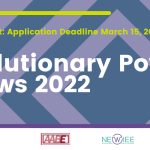MEPA Update Wrap-Up
There has been a lot of buzz in the environmental consulting world and amongst clients about the new Massachusetts Environmental Policy Act (MEPA) regulations and protocols that went into effect on January 1, 2022—particularly the changes with regard to Environmental Justice (EJ). There are a lot of questions about when and how the new regulations and protocols apply to projects, and what it means to comply with the outreach and impact analysis protocols.
So, I was excited that the NEWIEE community would get to hear about these changes directly from Tori Kim, Director of the MEPA Office and Assistant Secretary at the Executive Office of Energy and Environmental Affairs (EEA) for the Commonwealth of Massachusetts. In her presentation, she reviewed the timeline of the regulatory revisions process, and the goal of aligning the regulations with state policy and planning efforts for EJ, climate adaptation and resiliency, and greenhouse gas mitigation. This year, MEPA will partner with MassDEP’s Cumulative Impact Analysis (CIA) effort, and more information is likely to come out of these efforts that will further inform MEPA’s EJ Policies.
As she dove into the details of the changes and answered questions from the audience, there were several items of clarification that were helpful to hear:
- There is no change in jurisdiction—projects must still involve Agency Action and exceed MEPA review thresholds to trigger MEPA review.
- All Environmental Impact Reports (EIRs) must evaluate public health impacts, not just projects located in or near EJ populations. There is no protocol for this; MEPA expects that the details will be project-specific and will be identified as part of scoping for the EIR. These will be focused on the public health consequences of the environmental impacts identified in the ENF.
- MEPA estimates that 80% of new project filings would otherwise require an Environmental Notification Form (ENF) only, but now require an EIR due to their proximity to an EJ population. There are two options for streamlining the permitting effort in these situations:
- Single EIR: File an Expanded ENF and request a Single EIR
- Rollover EIR: File an Expanded ENF and Proposed EIR at the same time. If the Secretary finds no remaining issues, it can be published as is and treated as a Final EIR in the next Environmental Monitor. This is an adaptation from the existing rule that allows the Secretary to treat a Draft EIR as the Final if there is nothing more to scope.
- Increased engagement with EJ populations is required even if the project will have a net benefit. Proponents can contact MEPA to obtain an EJ reference list of local organizations and tribes. MEPA is working on increasing the support available to proponents to identify appropriate outreach measures.
- MEPA’s EJ Screening Form, which boils down the key facts about a project that should be included in notifications to EJ communities, is going to be translated into various languages and MEPA will be posting the translated form to their website.
- In analyzing impacts to EJ communities, the focus is on publicly available data sources. MEPA hopes that MassDEP’s CIA effort will identify more quantitative approaches later this year.
- The EJ greenhouse gas (GHG) emissions analysis should be conducted for buildings that are located within and/or likely to be used by EJ populations; it is not intended for buildings that are on the edge of the population and not likely to see their use.
There are still a lot of questions about how these protocols should specifically be applied to any given project, and how a proponent can determine whether they have done “enough” to provide meaningful engagement and to assess existing and proposed impacts. Ultimately the best course of action is to consult with the MEPA office to discuss the circumstances specific to a particular project, and work with MEPA staff to identify the appropriate format(s) and frequency of outreach and solidify the expectations around impacts analysis.
We will all be learning best practices as we go, and I look forward to seeing these policies continue to evolve.
Vivian Kimball
NEWIEE Board Member, VHB
© 2024 New England Women in Energy and the Environment (NEWIEE). NEWIEE is a non-profit, tax exempt organization under Section 501(c)(3) of the Internal Revenue Code.





